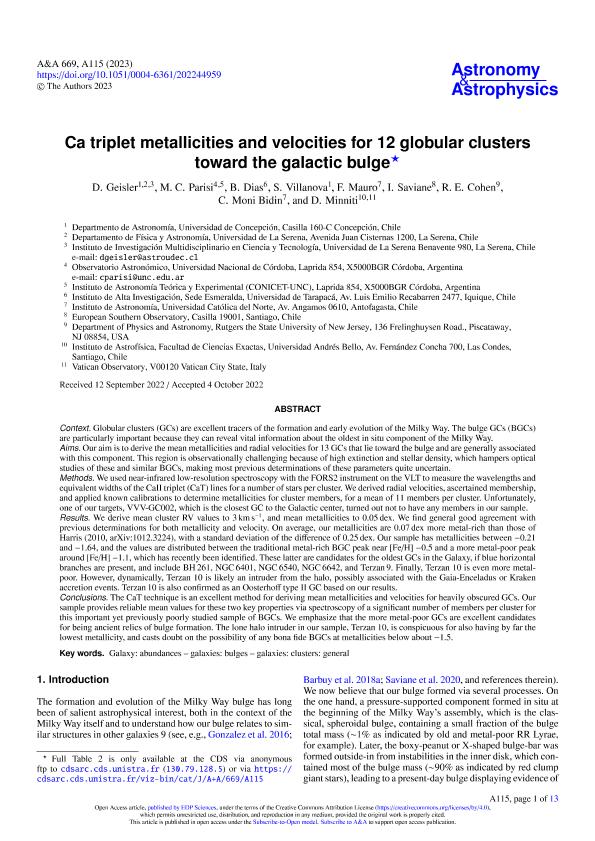Mostrar el registro sencillo del ítem
dc.contributor.author
Geisler, D.
dc.contributor.author
Parisi, Maria Celeste

dc.contributor.author
Dias, B.
dc.contributor.author
Villanova, S.

dc.contributor.author
Mauro, F.
dc.contributor.author
Saviane, I.
dc.contributor.author
Cohen, R. E.
dc.contributor.author
Moni Bidin, C.
dc.contributor.author
Minniti, D.
dc.date.available
2024-02-06T15:06:05Z
dc.date.issued
2023-01
dc.identifier.citation
Geisler, D.; Parisi, Maria Celeste; Dias, B.; Villanova, S.; Mauro, F.; et al.; Ca triplet metallicities and velocities for 12 globular clusters toward the galactic bulge; EDP Sciences; Astronomy and Astrophysics; 669; 1-2023; 115-128
dc.identifier.issn
0004-6361
dc.identifier.uri
http://hdl.handle.net/11336/225997
dc.description.abstract
Globular clusters (GCs) are excellent tracers of the formation and early evolution of the Milky Way. The bulge GCs (BGCs) are particularly important because they can reveal vital information about the oldest in situ component of the Milky Way. Aims. Our aim is to derive the mean metallicities and radial velocities for 13 GCs that lie toward the bulge and are generally associated with this component. This region is observationally challenging because of high extinction and stellar density, which hampers optical studies of these and similar BGCs, making most previous determinations of these parameters quite uncertain. Methods. We used near-infrared low-resolution spectroscopy with the FORS2 instrument on the VLT to measure the wavelengths and equivalent widths of the Call triplet (CaT) lines for a number of stars per cluster. We derived radial velocities, ascertained membership, and applied known calibrations to determine metallicities for cluster members, for a mean of 11 members per cluster. Unfortunately, one of our targets, VVV-GC002, which is the closest GC to the Galactic center, turned out not to have any members in our sample. Results. We derive mean cluster RV values to 3 km s~1, and mean metallicities to 0.05 dex. We find general good agreement with previous determinations for both metallicity and velocity. On average, our metallicities are 0.07 dex more metal-rich than those of Harris (2010, arXiv: 1012.3224), with a standard deviation of the difference of 0.25 dex. Our sample has metallicities between -0.21 and -1.64. and the values are distributed between the traditional metal-rich BGC peak near [Fe/H] -0.5 and a more metal-poor peak around [Fe/H] -1.1, which has recently been identified. These latter are candidates for the oldest GCs in the Galaxy, if blue horizontal branches are present, and include BH261, NGC6401, NGC6540, NGC6642, and Terzan9. Finally, Terzan 10 is even more metal- poor. However, dynamically, Terzan 10 is likely an intruder from the halo, possibly associated with the Gaia-Enceladus or Kraken accretion events. Terzan 10 is also confirmed as an Oosterhoff type II GC based on our results. Conclusions. The CaT technique is an excellent method for deriving mean metallicities and velocities for heavily obscured GCs. Our sample provides reliable mean values for these two key properties via spectroscopy of a significant number of members per cluster for this important yet previously poorly studied sample of BGCs. We emphasize that the more metal-poor GCs are excellent candidates for being ancient relics of bulge formation. The lone halo intruder in our sample, Terzan 10. is conspicuous for also having by far the lowest metallicity, and casts doubt on the possibility of any bona fide BGCs at metallicities below about -1.5.
dc.format
application/pdf
dc.language.iso
eng
dc.publisher
EDP Sciences

dc.rights
info:eu-repo/semantics/openAccess
dc.rights.uri
https://creativecommons.org/licenses/by-nc-sa/2.5/ar/
dc.subject
GALAXIES: BULGES
dc.subject
GALAXIES: CLUSTERS: GENERAL
dc.subject
GALAXY: ABUNDANCES
dc.subject.classification
Astronomía

dc.subject.classification
Ciencias Físicas

dc.subject.classification
CIENCIAS NATURALES Y EXACTAS

dc.title
Ca triplet metallicities and velocities for 12 globular clusters toward the galactic bulge
dc.type
info:eu-repo/semantics/article
dc.type
info:ar-repo/semantics/artículo
dc.type
info:eu-repo/semantics/publishedVersion
dc.date.updated
2024-02-06T14:06:01Z
dc.journal.volume
669
dc.journal.pagination
115-128
dc.journal.pais
Francia

dc.journal.ciudad
Paris
dc.description.fil
Fil: Geisler, D.. Universidad de La Serena; Chile
dc.description.fil
Fil: Parisi, Maria Celeste. Consejo Nacional de Investigaciones Científicas y Técnicas. Centro Científico Tecnológico Conicet - Córdoba. Instituto de Astronomía Teórica y Experimental. Universidad Nacional de Córdoba. Observatorio Astronómico de Córdoba. Instituto de Astronomía Teórica y Experimental; Argentina
dc.description.fil
Fil: Dias, B.. Universidad de Tarapaca.; Chile
dc.description.fil
Fil: Villanova, S.. Universidad de Concepción; Chile
dc.description.fil
Fil: Mauro, F.. Universidad Católica del Norte; Chile
dc.description.fil
Fil: Saviane, I.. European Southern Observatory; Chile
dc.description.fil
Fil: Cohen, R. E.. State University of New Jersey; Estados Unidos
dc.description.fil
Fil: Moni Bidin, C.. Universidad Católica del Norte; Chile
dc.description.fil
Fil: Minniti, D.. Universidad Andrés Bello; Chile
dc.journal.title
Astronomy and Astrophysics

dc.relation.alternativeid
info:eu-repo/semantics/altIdentifier/doi/http://dx.doi.org/10.1051/0004-6361/202244959
Archivos asociados
